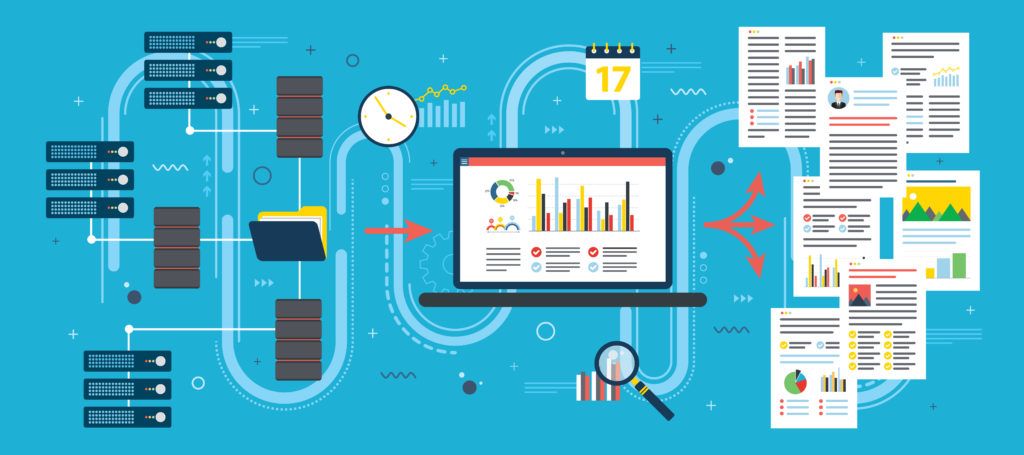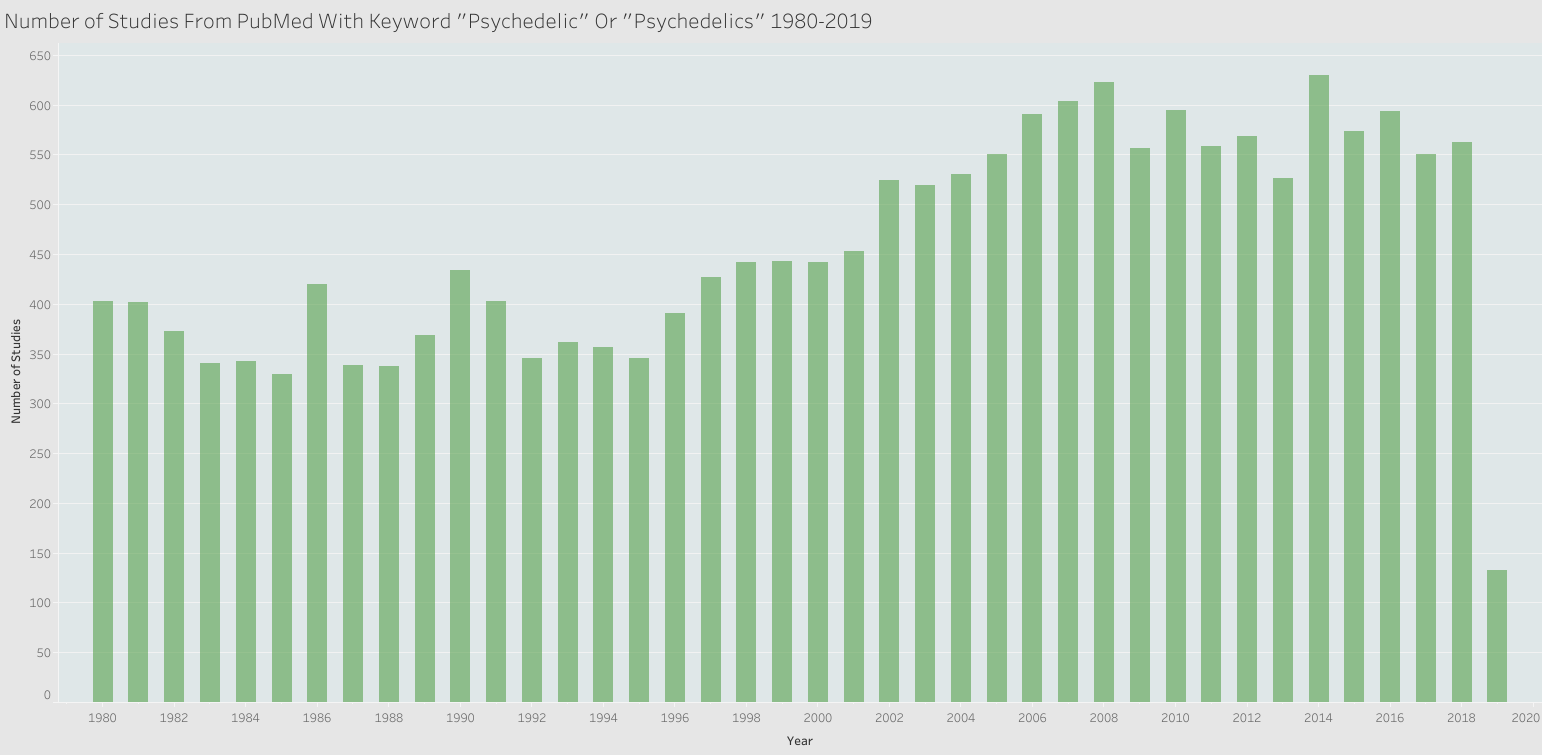
Research into psychedelic compounds is on the rise thanks to studies showing its therapeutic benefits for several conditions including depression and addiction. To get a better sense of the increase in studies over time and the most cited publications, PubMed and the program Publish or Perish were used to extract data about psychedelic studies from online sources. Specifically, this work examined the number of psychedelic studies published since 1980 and the top psychedelic research papers published in the last 10 years based on the number of citations received.
The bar chart in Figure 1 shows the increase in psychedelic research papers since 1980.

Figure 1: The number of research papers with the keywords “psychedelic” or “psychedelics” published from 1980-2019 according to PubMed (click to enlarge).
To find the top 10 papers of the last 10 years, the program Publish or Perish was used to extract psychedelic study data from Google Scholar. The results are shown below with a brief summary. The number of citations and year of publication for each is listed in Table 1.
1. Carhart-Harris RL, Erritzoe D, Williams T, et al. Neural correlates of the psychedelic state as determined by fMRI studies with psilocybin.
These researchers used a brain imaging technique called fMRI (functional magnetic resonance imaging) to examine how the human brain transitions from the normal waking state to the psychedelic state under the influence of psilocybin. The results indicated that the subjective effects of psilocybin (and other psychedelic drugs) are due to decreased activity and connectivity in key connector hubs in the brain which allows it to enter “a state of unconstrained cognition.”
2. Vollenweider FX, Kometer M. The neurobiology of psychedelic drugs: implications for the treatment of mood disorders.
This opinion piece published in Nature reviews the history of psychedelic drugs, their neurobiology, and use in therapy. From this knowledge, the authors then pose the hypothesis that psychedelic drugs may provide unique therapeutic approaches and mechanisms for treating psychiatric disorders based on their ability to alter glutamate-driven plasticity in the brain.
3. Carhart-Harris RL, Leech R, Hellyer PJ, et al. The entropic brain: a theory of conscious states informed by neuroimaging research with psychedelic drugs.
In this paper, researchers propose a new theory for the conscious state of the human brain. The theory incorporates principles of physics, neurobiology, and psychoanalysis. Using their theory, the researchers address questions related to different states of consciousness, how the brain maintains consciousness, and how brain functions change during sleep, psychotic states, and in the psychedelic state.
4. Nichols DE. Psychedelics.
Dr. David Nichols, Professor Emeritus of Pharmacology at Purdue University, penned this 2016 review article for Pharmacological Reviews at the request of the journal editors. The paper covers topics including the safety of psychedelics, how they work, expression of the 5-HT2A receptor, the effects of psychedelics, and their potential therapeutic uses.
5. Muthukumaraswamy SD, Carhart-Harris RL, Moran RJ, et al. Broadband cortical desynchronization underlies the human psychedelic state.
This study examined the effects of psilocybin on the brains of healthy volunteers using magnetoencephalography (MEG). The results showed that psilocybin reduced spontaneous oscillatory power in the posterior and frontal cortices, the default-mode network, and other areas. The researchers also pinpointed areas of the brain where psilocybin did not affect oscillations. Overall, the authors hypothesize that the subjective effects of psychedelics occur because of desynchronization of brain oscillatory rhythms in the cortex, which may be triggered by the excitation of 5-HT2A receptors in deep pyramidal cells.
6. González-Maeso J, Sealfon SC. Psychedelics and schizophrenia.
This 2009 study discusses how research on psychedelic drugs and the symptoms, neurochemical abnormalities, and treatments for schizophrenia have converged.
7. Tagliazucchi E, Carhart‐Harris R, Leech R, Nutt D, Chialvo DR. Enhanced repertoire of brain dynamical states during the psychedelic experience.
Using fMRI, researchers looked at the brains of 15 healthy volunteers before, during, and after being given an intravenous infusion of psilocybin or a placebo. They saw changes in the bilateral hippocampi and anterior cingulate cortex which rapidly corresponded with the administration of psilocybin. Another important finding was that psilocybin produced a wide variety of connectivity states in the brain compared to the placebo group, which the authors say is the result of increased entropy.
8. Carhart-Harris RL, Leech R, Williams TM, et al. Implications for psychedelic-assisted psychotherapy: functional magnetic resonance imaging study with psilocybin.
This study examined the subjective and neural responses of 10 healthy volunteers under psilocybin and placebo to positive autobiographical memories. fMRI was used to monitor the effects on the brains of the volunteers to evaluate the effectiveness of using psychedelics in psychotherapy. For psilocybin and placebo, the results showed “robust” activations of memories in the limbic system and striatal regions in the early phase of memory recollection and the medial prefrontal cortex in the late phase. However, under psilocybin and not placebo, the researchers saw additional visual and other sensory cortical activations in the late phase. Also, the volunteers not only rated the vividness of their memories and visual imagery higher on psilocybin compared to placebo, but the vividness was also significantly positively correlated to their subjective well-being at the study follow-up.
9. Krebs TS, Johansen P-Ø. Psychedelics and Mental Health: A Population Study.
This study extracted data from the US National Survey on Drug Use and Health to understand how the lifetime use of psychedelics relates to current mental health in the adult population. Of the 130,152 respondents drawn from the survey as a representative sample of the adult population, 21,967 of them reported they had used psychedelics their whole lives. After screening the data for these lifetime users for mental health conditions, the authors found no significant association between the lifetime use of any psychedelic, any specific psychedelic (LSD, psilocybin, mescaline, or peyote), or use of LSD in the past year and an increased rate of any mental health condition. Interestingly, the data revealed that “…in several cases psychedelic use was associated with lower rate of mental health problems.”
10. Hendricks PS, Thorne CB, Clark CB, Coombs DW, Johnson MW. Classic psychedelic use is associated with reduced psychological distress and suicidality in the United States adult population.
These researchers also extracted data from the US National Survey on Drug Use and Health to look for associations between the lifetime use of classic psychedelics and psychological distress and suicide. Using the survey data from 190,000 respondents from 2008-2012, they found that lifetime use of classic psychedelics was associated with significantly reduced odds of psychological stress in the past month, thinking about suicide in the past year, suicidal planning in the past year, and suicide attempts in the past year. In contrast, respondents with a lifetime illicit use of other drugs had an increased likelihood of these outcomes.
Table 1: The top 10 research articles with the keywords “psychedelic” or psychedelics” from 2009 to 2019 based on the number of citations in Google Scholar.
| Citation Count | Publication Year | Reference |
|---|---|---|
| 477 | 2012 | Carhart-Harris RL, Erritzoe D, Williams T, et al. Neural correlates of the psychedelic state as determined by fMRI studies with psilocybin. PNAS. 2012;109(6):2138-2143. doi:10.1073/pnas.1119598109 |
| 357 | 2010 | Vollenweider FX, Kometer M. The neurobiology of psychedelic drugs: implications for the treatment of mood disorders. Nature Reviews Neuroscience. 2010;11(9):642-651. doi:10.1038/nrn2884 |
| 297 | 2014 | Carhart-Harris RL, Leech R, Hellyer PJ, et al. The entropic brain: a theory of conscious states informed by neuroimaging research with psychedelic drugs. Front Hum Neurosci. 2014;8. doi:10.3389/fnhum.2014.00020 |
| 229 | 2016 | Nichols DE. Psychedelics. Pharmacological Reviews. 2016;68(2):264-355. doi:10.1124/pr.115.011478 |
| 184 | 2013 | Muthukumaraswamy SD, Carhart-Harris RL, Moran RJ, et al. Broadband cortical desynchronization underlies the human psychedelic state. J Neurosci. 2013;33(38):15171-15183. doi:10.1523/JNEUROSCI.2063-13.2013 |
| 150 | 2009 | González-Maeso J, Sealfon SC. Psychedelics and schizophrenia. Trends in Neurosciences. 2009;32(4):225-232. doi:10.1016/j.tins.2008.12.005 |
| 139 | 2014 | Tagliazucchi E, Carhart‐Harris R, Leech R, Nutt D, Chialvo DR. Enhanced repertoire of brain dynamical states during the psychedelic experience. Human Brain Mapping. 2014;35(11):5442-5456. doi:10.1002/hbm.22562 |
| 133 | 2012 | Carhart-Harris RL, Leech R, Williams TM, et al. Implications for psychedelic-assisted psychotherapy: functional magnetic resonance imaging study with psilocybin. The British Journal of Psychiatry. 2012;200(3):238-244. doi:10.1192/bjp.bp.111.103309 |
| 129 | 2013 | Krebs TS, Johansen P-Ø. Psychedelics and Mental Health: A Population Study. PLOS ONE. 2013;8(8):e63972. doi:10.1371/journal.pone.0063972 |
| 127 | 2015 | Hendricks PS, Thorne CB, Clark CB, Coombs DW, Johnson MW. Classic psychedelic use is associated with reduced psychological distress and suicidality in the United States adult population. J Psychopharmacol. 2015;29(3):280-288. doi:10.1177/0269881114565653 |
